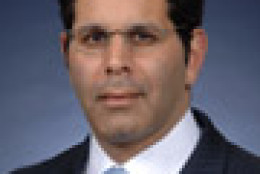Hubbard Radio Washington DC, LLC. All rights reserved. This website is not intended for users located within the European Economic Area.
National Institute of Standards and Technology
-
Jeremy Grant has led the National Strategy for Trusted Identities in Cyberspace (NSTIC) program since 2011. His last day will be in April.
February 19, 2015 -
The Defense Department's National Information Assurance Partnership's (NIAP) protection profile will be the governmentwide standard for agencies to use when ensuring the security of mobile apps. The Mobile Technology Tiger Team recommended the NIAP approach because of the collaboration and coordination across government and with industry.
February 19, 2015 -
If recent events on the cybersecurity front have scared the heck out of you, well, good. There's a lot you can do. How about start by reading the latest version of the government's premier publications on how to assess whether your security and privacy controls are adequate for today's hacker-plagued world? Dr. Ron Ross, FISMA Implementation Project and Joint Task Force Leader at the National Institute of Standards and Technology, joined Tom Temin on the Federal Drive to discuss what's in the newest revision of Special Publication 800-53-A.
December 19, 2014 -
When architects and engineers design buildings, they have to meet local building codes. But, simply meeting those codes won't ensure you have the most efficient design for the long haul. Joshua Kneifel is a research economist in the engineering laboratory at the National Institute of Standards and Technology. On the Federal Drive with Tom Temin, he told Federal News Radio's Lauren Larson about a new tool NIST engineers developed that lets builders measure the economic and environmental impacts of everything from the floor to the roof.
December 01, 2014 -
Non-federal organizations and contractors may have sensitive federal information on their computers, but there are no consistent rules on how to keep that information secure. The treatment of Controlled Unclassified Information is the focus of a new set of recommendations. Ron Ross is a National Institute of Standards and Technology fellow. He is the lead author of the new guide, and joined Tom Temin on the Federal Drive to explain more.
November 24, 2014 -
Rumors have been circulating over the last few months about a possible reconsideration of the identity management technologies agencies are implementing under Homeland Security Presidential Directive-12 (HSPD-12).
November 03, 2014 -
The National Institute of Standards and Technology has released its final version of the Cloud Computing Technology Roadmap. It incorporates more than 200 comments from government and industry, and it's intended to support the government's adoption of cloud computing. Bob Bohn is the Cloud Technical Program Manager at NIST. He joined Tom Temin on the Federal Drive with details on the roadmap.
October 29, 2014 -
You might be a dog on the Internet, but nobody can tell for sure. Confidence in who people say they are online is vital to a cyber secure future for government and industry. People at the National Strategy for Trusted Identities in Cyberspace have been working on this problem within the Commerce Department for a couple of years now. Jeremy Grant is senior executive advisor for Identity Management at the National Institute of Standards and Technology. He joined Tom Temin on the Federal Drive to discuss some recent progress.
October 20, 2014 -
It seems like the whole world is going mobile, and that includes the federal government. Agencies are using more and more apps for collaboration and productivity. But some apps increase the potential for exposing government data. To help you guard against these security risks, the National Institute of Standards and Technology is providing tips to the federal community for vetting third-party apps. Computer Scientist, Tom Karygiannis, joined Tom Temin on the Federal Drive to discuss the guidelines.
August 28, 2014 -
The National Institute of Standards and Technology kicks off the Global City Teams Challenge in September. Tech-savvy members from the federal government and private sector will come together to address issues including air quality, traffic management and emergency services coordination, all through the use of smart technology. Sokwoo Rhee, associate director for Internet of Things and Cyber-Physical Systems at NIST, joined Tom Temin on the Federal Drive to discuss what the agency hopes to accomplish.
August 26, 2014 -
A savings of $2 million per year is now being realized at the U.S. Mint after an innovative engineer stepped out of the box and asked a friend at another federal agency for help. In part three of our special report, Rainmakers and Money Savers, Federal News Radio takes you inside the lab where a group of engineers and nanotribologists combined their expertise to solve a coin-making problem and, in turn, saved a lot of cash.
August 14, 2014 -
The National Information Assurance Partnership, the U.S. implementation of what was supposed to be a faster, cheaper process to verify the cybersecurity of commercial IT products, turned out to be so slow and expensive that few companies could afford to go through it. But officials said they hope a recent overhaul in the procedures will breathe new life into the program.
July 02, 2014 -
It keeps getting easier to manufacture a counterfeit computer chip. Experts say federal information systems increasingly are at risk because of flaws in their supply chains. It is not just a question of fake parts. Genuine ones that have been tampered with, or are just poorly made, can cause damage. The National Institute of Standards and Technology is revising guidelines for agencies to help them secure their supply chains. Jon Boyens is an IT specialist in the security outreach and integration group at NIST. He spoke with Emily Kopp on the Federal Drive.
June 10, 2014 -
The National Institute of Standards and Technology has launched a four-part plan to help agencies build more secure IT systems. NIST Computer Scientist Ron Ross, who guided a new publication on the issue, tells the Federal Drive with Tom Temin and Emily Kopp that the same engineering principles that apply to bridges and buildings should apply to IT. That is, security should be built in, not added later.
May 15, 2014











